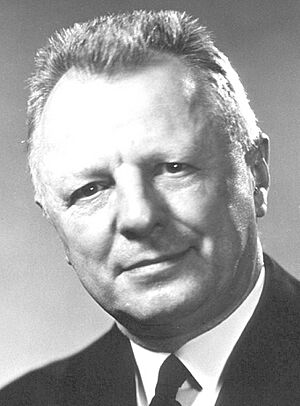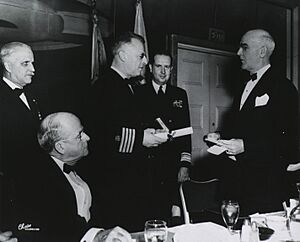H. Trendley Dean facts for kids
Quick facts for kids
H. Trendley Dean
|
|
|---|---|
 |
|
| Born |
Henry Trendley Dean
August 25, 1893 Winstanley Park (now East St. Louis), Illinois, U.S.
|
| Died | May 13, 1962 (aged 68) |
| Alma mater | St. Louis University |
| Occupation | Dentist |
| Known for | Work on water fluoridation |
| Title | Director of National Institute of Dental Research |
| Term | 1948–1953 |
| Successor | Francis A. Arnold Jr. |
Henry Trendley Dean (born August 25, 1893 – died May 13, 1962) was a very important American dentist. He was the first director of the National Institute of Dental Research in the United States. He is best known for his groundbreaking work on adding fluoride to water. This research helped prevent tooth decay and improve dental health for many people.
Early Life and Career
Henry Trendley Dean was born in Winstanley Park, Illinois, on August 25, 1893. This area is now part of East St. Louis. He earned his degree in dentistry from St. Louis University in 1916. After graduating, he started his own dental practice in Wood River, Illinois.
During World War I, Dean served in the United States Army. He returned to his dental practice in 1919. In 1921, he joined the United States Public Health Service. He worked in several U.S. Marine Hospitals.
In 1931, Dean began working in dental research at the National Institute of Health. He became the director of the dental research section in 1945. After World War II, he led studies on health patterns for the Army in Germany. When the U.S. Congress created the National Institute of Dental Research in 1948, Dean was chosen to be its first director. He held this important position until he retired in 1953.
Discovering Water Fluoridation
Dr. Dean's most famous work involved studying how fluoride in water affects teeth. Other dentists, like Frederick McKay, noticed that people in some areas had brown stains on their teeth. They asked Dean to investigate this issue in 1931.
Dean was part of a team that studied how much fluoride in drinking water was best. They wanted to find a level that would prevent dental caries (cavities) but cause only very mild tooth staining, known as dental fluorosis.
In 1934, Dean created a way to measure how severe dental fluorosis was. In 1939, he shared important findings from four towns in Illinois. He found that children in towns with low fluoride levels had 2 to 3 times more cavities. The biggest difference was in cavities between the front teeth. Kids in low-fluoride towns had 16 times more cavities there.
Dean's research showed that fluoride could prevent cavities. However, he also knew that too much fluoride could cause staining. He spent his career finding the perfect amount of fluoride. This amount would protect teeth without causing damage. In 1952, Dean and Frederick McKay received the Albert Lasker Award for Clinical Medical Research. This award recognized their important work with fluoride.
Later Life and Legacy
After retiring in 1953, Dr. Dean continued his work with the American Dental Association. He served as the Secretary of its Council on Dental Research. In this role, he kept supporting and defending the idea of adding fluoride to public drinking water.
He often traveled to speak about water fluoridation in the U.S. and other countries. He helped explain the benefits and answered questions from those who were against it. In 1949, he received the Gorgas Medal for his contributions. Henry Trendley Dean passed away in 1962 after a long illness.
Today, the International Association for Dental Research honors his memory. They have an award named after him, the H. Trendley Dean Memorial Award. This award recognizes excellent research in public health and how diseases spread.


